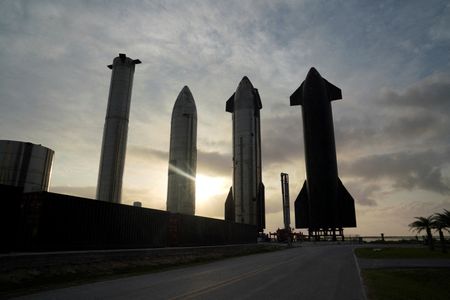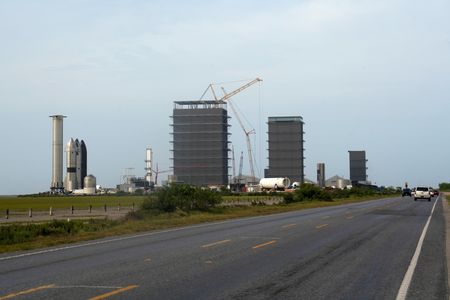By Joey Roulette
WASHINGTON (Reuters) -SpaceX is targeting early December to launch its giant Starship rocket system into orbit for the first time, a pivotal demonstration flight as it aims to fly NASA astronauts to the moon in the next few years, a U.S. official said on Monday.
Billionaire Elon Musk’s SpaceX has sought for years to send its towering next-generation rocket system into orbit from the company’s private launch facilities in Texas, where it has only launched prototypes of Starship’s upper half some 6 miles (10 km) high to demonstrate landing attempts.
The December mission will test the entire system for the first time, involving the company’s 230-foot (70-meter) Super Heavy booster to lift the 160-foot (50-meter) Starship spacecraft into orbit.
“We track four major Starship flights. The first one here is coming up in December, part of early December,” Mark Kirasich, a senior NASA official overseeing development of the agency’s Artemis moon program, said during a live-streamed NASA Advisory Council meeting.
The Super Heavy booster would return to land, while the orbital Starship spacecraft would re-enter Earth’s atmosphere roughly 90 minutes later to splashdown dozens of miles off a Hawaiian coast, according to regulatory documents SpaceX filed last year.
Further ground tests with the rocket and regulatory reviews could delay the debut orbital mission beyond December. The U.S. Federal Aviation Administration, which oversees commercial launch site safety, has not yet granted a license for the mission to SpaceX, part of Musk’s growing universe of companies that also includes Tesla and Twitter.
The FAA would determine whether to grant SpaceX a license “only after SpaceX provides all outstanding information and the agency can fully analyze it”, an FAA spokesman said Monday. SpaceX did not return a request for comment.
Starship is poised to be SpaceX’s flagship rocket system once fully developed, succeeding the company’s fleet of reusable Falcon 9 rockets as a more powerful and fully reusable ride to space for large batches of commercial satellites, space tourists and professional astronauts.
NASA in 2021 picked SpaceX’s Starship to land humans on the moon around 2025, for the first time since 1972. That mission, under a roughly $3 billion contract, requires several spaceflight tests in advance that could delay the 2025 moon landing mission.
Read more:
Wall Street asks if Musk can manage Twitter, Tesla and more
SpaceX capsule splashes down, returning 4 astronauts from Space Station
(Reporting by Joey Roulette; Editing by Franklin Paul, Lisa Shumaker and Alex Richardson)


